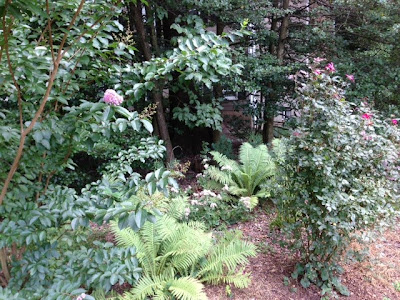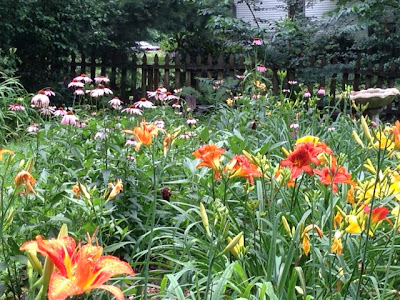Come On! You Can Do It!
Is it any wonder that shy spring flowers are timid after this winter? Even as late as Sunday they were being pelted with snow, sleet and freezing rain.
Somehow — the angle of the light, the lengthening days — the world is still preparing itself for the new season. There’s that promising pink haze at the top of the tall trees, the way buds look 80 feet away. And there are green shoots and flowers pushing up all over town. Rumor even has it that the cherry blossoms are primping for their big show.
But here on the shady side of morning, the daffodils are looking less than sure of themselves. Yesterday I bent low, snapped a few shots, and gave them a pep talk. “Come on, guys. You can do it!”
They had nothing to say for themselves; only hung their heads a little lower. But I have confidence in them. Sixty-degree temperatures are forecast again for today. It’s only a matter of time …
Hidden Garden
This is a corner of the yard you can’t see from inside, the outer edge of a small grove of trees that softens and shelters half the house.
Ferns, hollies, a crepe myrtle and a knockout rose are gathered here with little thought to their placement except hope that the rose and crepe myrtle would have enough light to bloom.
There is no gate, no wall or key, and it holds no fairy magic. But I like to think of this place as a hidden garden, because though it’s visible to neighbors, it is, for the most part, invisible to me.
Late Summer Color
Purples and yellows splash color into the late-summer garden. Chicory blooms blue along the roadside. And for contrast, the bridal-veil white of clematis paniculata.
Summer may not have been hot this year, but it has been colorful. Plentiful rain has kept the grass green, has meant no watering, no parched soil.
Wildflowers scarce in other seasons are emboldened this year. The soil has a memory, especially when it rains.
Late summer color softens the blow, warms these days of waning light.
The Volunteer
I didn’t plant this flower, didn’t even notice it until last week. A volunteer, I suppose, a morning glory that decided to glorify us on its own, not sought out, not planted (its seed nicked and soaked as the instructions on the morning glory seed packet suggest).
Instead, it grew from escaped seeds, from flowers settled two, three summers ago, blown to the other side of the deck stairs, cosseted by leaf mold and azalea shade. Its green tendrils twined around the evergreen branches, spiraling up and around, through sunlight and darkness. Invisible for one season at least, maybe two.
And now, finally, it finds itself here, at the rag-tag end of summer, glinting in the sunlight of an August morning.
The volunteer proves that nature has its own designs and humans are often not a part of them. Beauty, however, often is.
Moon Garden
A colleague asked if I’d heard of moon gardens — and now I can’t stop thinking about them.
I imagine a balmy night, slight breeze, whiff of honeysuckle. A full moon rising. White plants overlooked in the daytime shine out in the darkness: dusty miller, sweet alyssum, night phlox.
And then there are flowers that only bloom at night: moon flower, four o’clocks, evening primrose.
Some plants are more fragrant in the evening: flowering tobacco, pinks, night gladiolus.
Or maybe it is that we, the tired gardeners, are more open to their scent.
Flowery Bower
So far so good in this hard-fought battle between deer and day lily. A battle in which the day lily does nothing except bloom and be beautiful. A battle waged by the human on the day lily’s behalf. A human with a spray can of Invisible Fence.
Let us now praise the human and the spray can. Let us now praise the beauty that is the result.
It’s midsummer. The rain has stopped. The lilles are blooming. It’s a flowery bower.
Anything but Routine
Every spring I plant impatiens in the front garden and tomatoes and basil in pots on the deck. That’s what I did yesterday. The begonias will wait till the weekend. These annuals join the perennials, the day lilies and climbing rose and (right now) the slender irises and steadfast peony.
This is not a wide array of plants, but experience has proven what will grow in our shady yard — and what will not (forget a vegetable garden).
Is this what makes for routine? All the countless failed experiments — geraniums, petunias, speedwell, columbine? The list of plants that won’t grow in this shady, clay soil is much longer than the list of those that will. But all it takes is a few. And the knowledge of what those few are makes gardens grow a little faster, bloom a little brighter.
(The garden of my dreams, not my reality! It’s anything but routine.)
The Aftermath
Two days of weather and it’s raining not just drops but petals.
Blossoms fall from the trees, cling to sidewalks, cars — and park benches, too.
A house I passed yesterday in the twilight caught my eye, its front lawn covered with vivid pink petals, from a Kwanzan cherry, I think. If I’d had time I would have stopped and snapped a picture.
Instead I remember this: an ordinary house, a tree branching green, a yard with pink snow.
Stem, Bud, Leaf
I write about this hedge every year. It’s a welcome subject today, when there are so many things I’d rather not write about. So many sad and unnatural things.
The hedge, on the other hand, spends its days just being a hedge. It was trimmed earlier in the season, so it has the sad openness of a little boy after his first haircut, curls heaped around the chair.
But the haircut has not deterred the hedge from performing its hedgely duty — the steady transformation from brown stem to pink bud to green leaf.
Some years it takes weeks for this to happen, and I hold my breath. But this year it took only a few days. An ordinary miracle.


